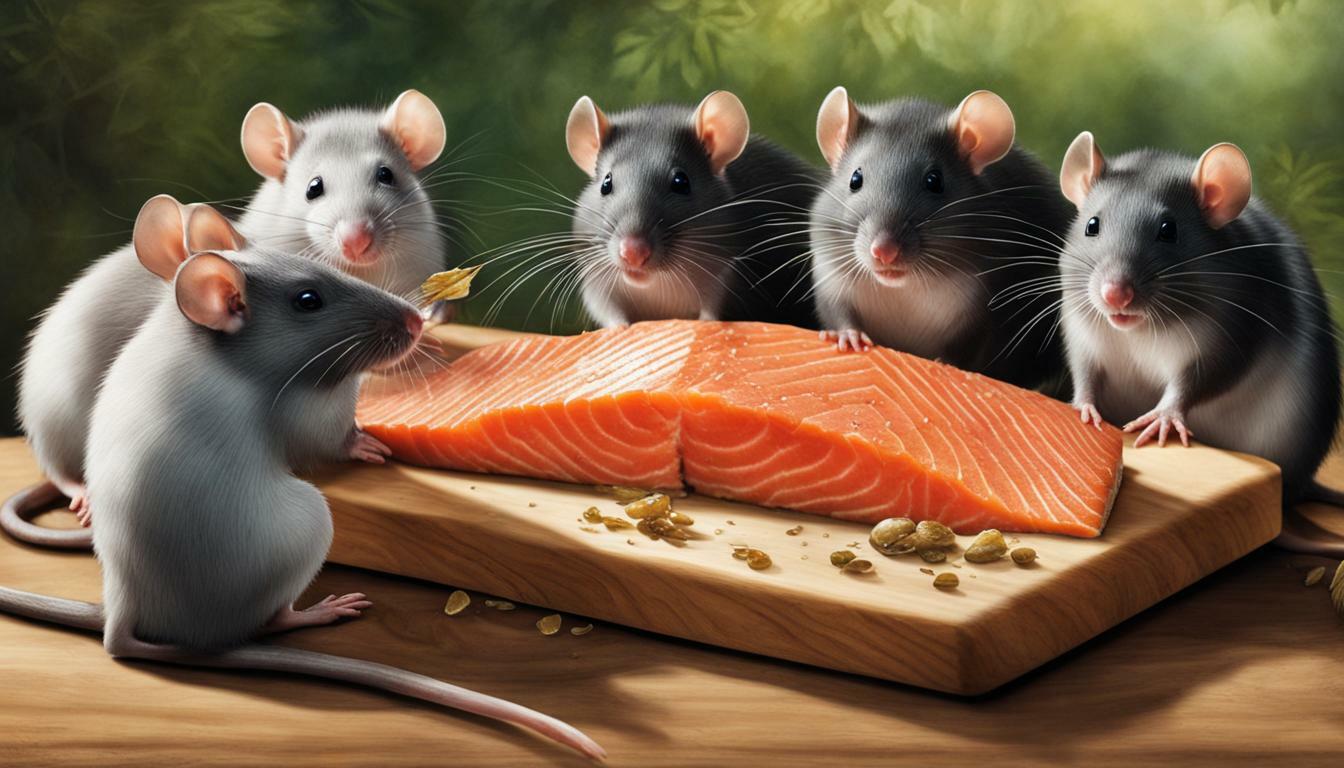If you’re wondering whether it’s safe to feed your pet rat salmon, you’ve come to the right place. In this article, we will explore the topic of pet rat nutrition and delve into whether rats can safely consume salmon. We will discuss the nutritional benefits of salmon, the recommended portion size and frequency, and other types of fish and seafood that rats can enjoy.
Key Takeaways:
- Rats can eat salmon, but it should be fed in small amounts as part of a balanced diet.
- Salmon is rich in omega-3 fatty acids, protein, and B vitamins, making it a nutritious choice for rats.
- It is important to consider the portion size and frequency of feeding salmon to rats to maintain a well-rounded diet.
- Other types of fish and seafood, such as tuna, herring, cod, and shrimp, can also be included in a rat’s diet for variety.
- Always ensure that the fish and seafood provided to rats are fresh and properly cooked to avoid any potential health risks.
The Nutritional Benefits of Salmon for Rats
Salmon is packed with essential nutrients that can contribute to the overall health of your pet rat. Its high nutritional value makes it one of the healthiest fish options for rats. This delicious fish is a great source of omega-3 fatty acids, which are important for supporting brain function and reducing inflammation. Additionally, salmon is rich in protein, which is essential for muscle development and growth in rats.
The B vitamins found in salmon, such as niacin, thiamine, and vitamin B12, are crucial for maintaining a healthy metabolism and promoting proper nerve function in your pet rat. These vitamins play a vital role in supporting your rat’s overall well-being.
What sets salmon apart from other fish is its low levels of mercury and calories. This means that your rat can enjoy the nutritional benefits of salmon without the worry of harmful mercury exposure. It is important, however, to feed salmon to your rat in small amounts as part of a balanced diet, ensuring that their nutritional needs are met without overfeeding.
| Nutrient | Amount per 100g |
|---|---|
| Protein | 20g |
| Omega-3 fatty acids | 2.5g |
| Vitamin B12 | 3 mcg |
Remember, while salmon is a nutritious addition to your rat’s diet, variety is key. Along with salmon, you can offer your rat other types of fish such as tuna, herring, cod, and shrimp to provide a well-rounded diet. This will ensure that your pet rat receives a wide range of nutrients for optimal health.
Recommended Portion Size and Frequency of Salmon for Rats
While salmon can be a nutritious addition to your rat’s diet, it’s important to feed it in moderation. Rats have specific dietary requirements, and feeding them too much salmon can upset their nutritional balance. As a general guideline, it is recommended to offer your pet rat salmon once or twice a week, in small portions.
The appropriate portion size of salmon for rats will depend on their size and individual needs. As a rule of thumb, a small rat can be fed about a teaspoon of salmon, while larger rats can be given up to a tablespoon. It’s important to note that this should only make up a small portion of their overall diet, with the majority consisting of a balanced rat-specific pellet or block food.
Tips for Feeding Salmon to Your Rat
- Always ensure that the salmon is cooked thoroughly before offering it to your rat. Raw or undercooked salmon can contain harmful bacteria that can be dangerous to rats.
- Remove any bones from the salmon before serving it to your rat. Bones can pose a choking hazard and should be avoided.
- Do not add any seasoning or spices to the salmon. Rats have sensitive digestive systems, and certain seasonings can be harmful to them.
- Rotate between different types of fish and seafood to provide variety in your rat’s diet. Tuna, herring, cod, and shrimp are all safe options that can be included in their meals.
Remember to always consult with your veterinarian or a rodent nutrition specialist to ensure that you are providing the best diet for your pet rat. They can provide personalized recommendations based on your rat’s specific needs and health conditions. By following these guidelines, you can safely include salmon as a nutritious treat for your furry friend.
| Type of Fish/Seafood | Nutritional Value |
|---|---|
| Salmon | Rich in omega-3 fatty acids, protein, and B vitamins |
| Tuna | High in protein and omega-3 fatty acids |
| Herring | Good source of omega-3 fatty acids, protein, and calcium |
| Cod | Low in fat and calories, high in protein |
| Shrimp | High in protein and low in fat |
Other Types of Fish and Seafood Rats Can Eat
If you’re looking to diversify your pet rat’s diet beyond salmon, there are other fish and seafood options that are safe for them to eat. Rats can enjoy a variety of fish such as tuna, herring, cod, and shrimp. These alternatives also offer nutritional benefits and can be incorporated into your rat’s balanced diet.
Tuna is another popular choice for rats. It is a great source of protein and contains omega-3 fatty acids, which are essential for their overall health. However, it is important to note that canned tuna should be given sparingly due to its high sodium content. Fresh or frozen tuna is a better option for your pet rat.
Herring is another fish that rats can safely consume. It is rich in essential fatty acids, vitamins, and minerals. Herring can provide your rat with valuable nutrients that contribute to their overall well-being. Ensure that the fish is properly cooked and boneless before offering it to your furry friend.
In addition to fish, rats can also enjoy certain types of seafood. Cod is a lean white fish that is low in fat and calories, making it a healthy choice for rats. It offers a good source of protein and contains essential nutrients like omega-3 fatty acids and vitamin B12. Shrimp is another seafood option that rats can enjoy in moderation. It is packed with protein and contains essential amino acids that support their growth and development.
| Type of Fish/Seafood | Nutritional Benefits |
|---|---|
| Tuna | High in protein and omega-3 fatty acids |
| Herring | Rich in essential fatty acids, vitamins, and minerals |
| Cod | Low in fat and calories, good source of protein |
| Shrimp | High in protein, essential amino acids |
When introducing new fish or seafood into your rat’s diet, it is important to do so gradually. Start with small portions and observe how your rat reacts to it. Monitor their digestion and any potential allergies or adverse reactions. Remember to always prepare the fish or seafood properly, removing any bones or shells before offering it to your pet rat.
By incorporating a variety of fish and seafood into your pet rat’s diet, you can provide them with a well-rounded nutritional profile while keeping their meals interesting and enjoyable. Remember to consult with a veterinarian or nutritionist to ensure you are offering the appropriate portion sizes and frequency of these foods to your furry friend.
Conclusion
Feeding your pet rat salmon can be a healthy choice, but remember to provide it in moderation as part of a well-rounded diet. Salmon is one of the healthiest fish for rats due to its nutrient density and low levels of mercury and calories. This fish is packed with essential omega-3 fatty acids, protein, and B vitamins, which contribute to their overall well-being.
When including salmon in your rat’s diet, it is important to offer small portions to prevent overfeeding. A recommended portion size for a pet rat is about the size of their own paw, typically given once or twice a week. This will help ensure they receive the nutritional benefits of salmon without an excessive intake of calories.
In addition to salmon, there are other fish and seafood options that rats can enjoy. Tuna, herring, cod, and shrimp are safe choices that provide similar health benefits to salmon. These alternatives can be incorporated into your rat’s diet to provide variety and ensure a well-balanced nutritional intake.
Remember, while fish can be a valuable addition to your pet rat’s diet, it should not be the sole source of nutrition. It is essential to offer a diverse range of foods, including fresh fruits, vegetables, grains, and a high-quality rat pellet or mix. Consult with your veterinarian to create a suitable diet plan based on your rat’s specific nutritional needs.
FAQ
Can rats eat salmon?
Yes, rats can eat salmon. It is one of the healthiest fish to give them because it is nutrient-dense and low in mercury and calories.
What are the nutritional benefits of salmon for rats?
Salmon is rich in omega-3 fatty acids, protein, and B vitamins, which provide various health benefits for rats.
How much salmon should I feed my rat?
It is recommended to feed rats small amounts of salmon as part of their diet. Portion size and frequency should be balanced to ensure a healthy diet.
Can rats eat other types of fish?
Yes, rats can also eat other types of fish such as tuna, herring, cod, and shrimp. These fish provide additional nutritional options for rats.
Are fish skins and fish eggs safe for rats to eat?
Yes, fish skins and fish eggs can be safely consumed by rats. However, moderation should be exercised to maintain a balanced diet.
What other types of seafood can rats eat?
Rats can also consume various other types of seafood such as mussels, clams, and squid. These options provide a diverse range of nutrients for rats.




